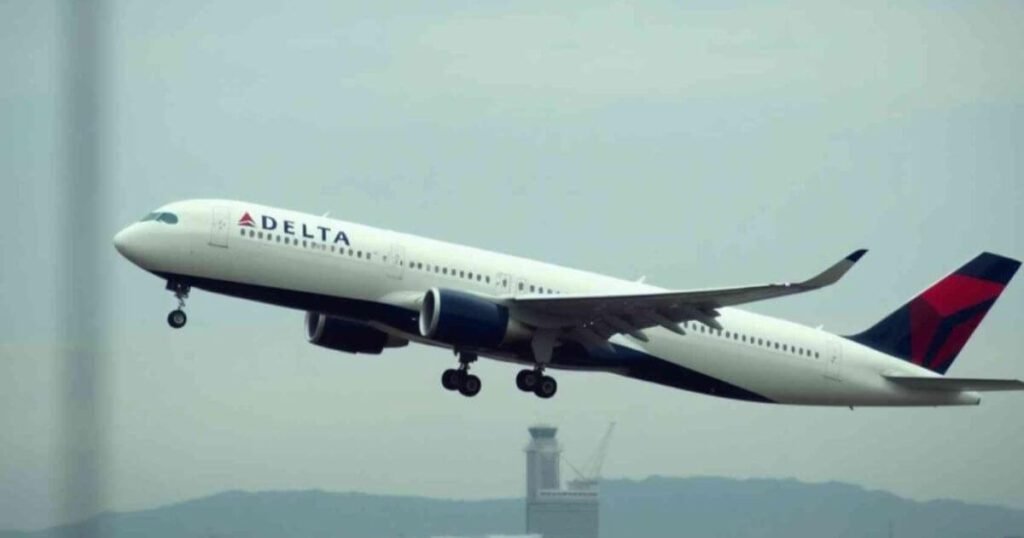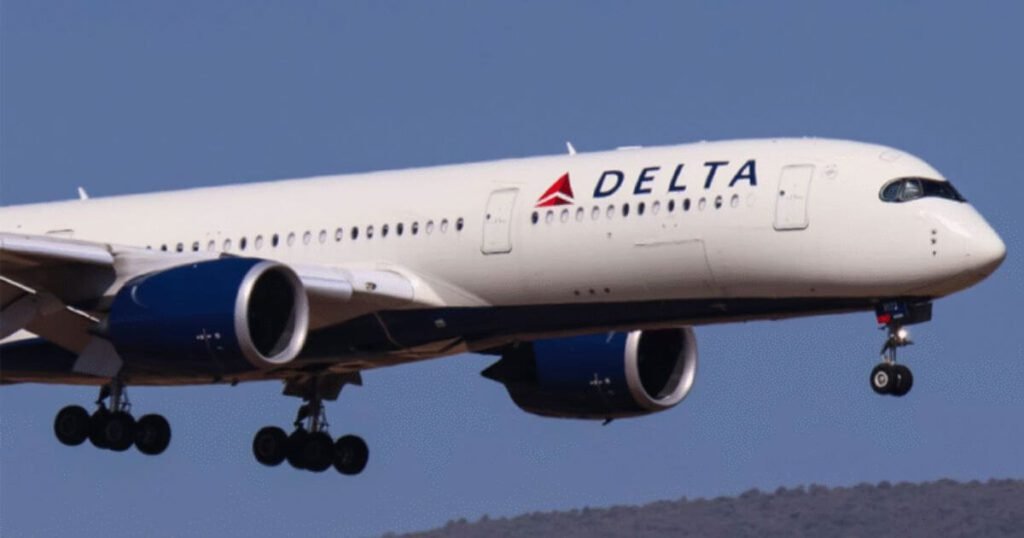The May 28, 2025 incident involving Delta flight DL275 revealed how modern aircraft systems can fail unexpectedly during transpacific operations. This Airbus A350-900 with registration N508DN experienced critical anti-ice system malfunction while flying over the Pacific Ocean at 38,000 feet. Passengers aboard this Detroit to Tokyo route witnessed professional crew response when Rolls-Royce Trent XWB engine sensors detected abnormal readings. The diversion to Los Angeles International Airport demonstrated how aviation safety protocols prioritize passenger safety over operational costs, resulting in $2.3 million in total losses for the airline.
LAX served as the ideal diversion airport due to its comprehensive ground facilities and Delta hub infrastructure. Flight crews executed established emergency procedures while maintaining calm communication with all 300 passengers throughout the 12+ hour journey. This event highlighted gaps in predictive maintenance technology, where AI systems could have detected early warning signs three to six hours before takeoff from Detroit Metro Airport.
What Happened on Delta Flight DL275 Before Landing at LAX
The aircraft experienced sensor anomalies in its anti-ice system during cruising altitude over the Pacific Ocean. Bleed air pressure readings showed 25 percent deviation while valve response registered 300 percent above normal parameters. Temperature fluctuations reached dangerous levels as ice accumulation threatened engine integrity on the Airbus A350.
Pilots initiated emergency procedures after system diagnostics revealed failing components could compromise safety. The Trent XWB’s heated air circulation dropped 50 percent, creating high-risk icing conditions at -50°C. Captain coordination with Delta’s operational control center and ATC determined LAX offered optimal runway length and maintenance capabilities for this mechanical emergency.
Flight Details at Departure
Passengers boarding DL275 anticipated a straightforward transpacific journey from Detroit to Tokyo Haneda. The A350 departed with business travelers, families, and tourists expecting 12 hours of smooth flying across the Pacific. Registration N508DN carried 300+ souls bound for Japan’s culture and connecting flights. The initial phase proceeded smoothly until technical trouble emerged five hours into the long-range journey.
Premium economy and business class seats were filled with travelers who had specifically chosen this route for its reliability and timing. Hotel reservations and business meetings were scheduled around the reputation of Delta’s fuel efficiency and passenger comfort. This popular choice for long-haul journeys connects Detroit’s strategic location with proximity to central Tokyo, making it highly desirable for Eastern and Central United States passengers.
Why Los Angeles Was the Best Place to Land
Los Angeles International Airport emerged as the ideal choice when flight crews needed a suitable airport for this heavy international aircraft. LAX offers extensive ground facilities, medical response teams, and customs processing capabilities essential for unscheduled arrivals. The West Coast’s largest airport excels at handling diversions with immigration and customs capacity designed for such circumstances. Gate assignment coordination and ground crew preparation made LAX operationally superior to other options.
Airport response protocols trigger emergency vehicles standing by as precautionary measures during unexpected landings. Passenger service agents deployment ensures immediate care for affected travelers, while comprehensive inspection procedures can begin returning the aircraft to service. The infrastructure plays a key role in managing these rare but critical situations effectively.
Technical Reasons Behind Diversion
Engine warning systems detected ice buildup on vital engine parts during high-altitude travel over freezing regions. The Rolls-Royce engines experienced anti-ice system issues that posed real risk of power loss or potential engine failure. Flight crew received serious warning alerts while cruising 620 nautical miles southwest of Anchorage in remote, icy areas. Pilots made an immediate announcement during what passengers thought was a routine cruise phase of their long journey.
System assessment and risk evaluation determined the severity warranted discontinuing the Tokyo mission. Modern aircraft feature multiple redundancies, but certain failures demand immediate landing at the nearest suitable airport. Checklist-driven decision processes guided the crew through coordinating with air traffic control and Delta’s operational control center to assess fuel reserves and available diversion airports.
The Cost of a Diversion for Airlines
Delta faces approximately $2.3 million in direct costs from this single operational challenge, including fuel, crew duty limits, and rebooking expenses. Airlines must absorb hotels on short notice, food, passenger care, and updates while managing hundreds of affected lives and schedules. The incident creates brand risks with potential $840,000 in lost future income from damaged trust and future bookings. Reports suggest individual travelers may receive up to $2,800 in compensation depending on missed connections and delays.
Logistically challenging situations like this prove stressful, disruptive, and confusing for crews managing reputationally sensitive circumstances. The cost considerations never override passenger health emergencies or safety protocols, as airlines invest heavily in crew training programs to handle such scenarios. This investment in professional response demonstrates the industry’s commitment to safety first principles.
Passenger Experience During a Diversion
Passengers aboard DL275 experienced an ordinary travel day that transformed into headlines within 15 minutes. The routine cruise phase was interrupted when sleeping travelers using in-flight entertainment and laptops heard an announcement about the diversion. What seemed like confusing operational decisions suddenly became clear – safety protocols were prioritizing human lives over flight costs and schedule convenience.
Business class and economy travelers alike witnessed crew professionalism during this costly emergency. Passenger service agents coordinated hotel accommodations and rebooking while maintaining calm throughout the process. The 12 hours of interrupted international travel demonstrated how airlines protect passengers when technical trouble emerges during high-altitude travel over remote areas.
Crew Response and Professionalism
Flight crew demonstrated sophisticated decision-making processes when sensor data indicated anti-ice system failure during harsh weather conditions. The captain’s conservative approach reflected training that prioritizes safety margins over profits. Crew overtime became necessary as technicians and engineers conducted thorough inspections to ensure aircraft could return to service safely.
Professional adaptability shone when coordination between ground crew, medical staff, and airport police created seamless passenger transfers. Delta Air Lines operations supported the crew’s binding decision to land at LAX rather than continue to Tokyo Haneda Airport. This systematic response reinforced public trust in commercial aviation safety.
Could AI Have Predicted and Prevented the Problem?

AI tools and predictive monitoring systems could have detected engine sensor reliability issues before departure from Detroit Metropolitan Wayne County Airport. Real-time operational monitoring combined with enhanced maintenance systems might have identified airflow problems affecting hot bleed air circulation. Telemedicine and live data analysis could prevent similar diversions through smarter technology integration.
Machine learning algorithms analyzing temperature variations in engine compressors and fan blade performance might have flagged ice accumulation risks. Aviation systems equipped with stronger AI capabilities could monitor performance degradation patterns, enabling preventive measures rather than reactive emergency responses during transpacific flights.
What the Aviation Industry Can Learn from This
Industry statistics show annual diversion rates of 0.1% for commercial flights, yet each incident provides valuable lessons for future improvements. The $1.98 million revenue loss and $332,000 direct costs demonstrate why investing in optional predictive tools makes financial sense. Federal Aviation Administration regulations support captains making safety-focused decisions, but industry challenges require proactive solutions.
Aviation professionals must embrace technological complexity while maintaining fundamental principles of safety first. Weather extremes and mechanical issues will continue threatening operations, but smarter crew training and system redundancy can minimize disruptions. This costly diversion serves as a starting point for building safer skies through continuous learning and improvement.
The Significance of This Route
Flagship transpacific routes connecting America’s industrial heartland through DTW to Japan’s capital represent critical international aviation corridors. These long-range flights demonstrate Delta’s commitment to operational excellence across Pacific networks.
The HND to Los Angeles connection serves as a vital link for business and leisure travelers. This route typically requires 13 hours of flight time, showcasing modern aircraft capabilities and airline operational expertise.
Post-Diversion Protocols
CBP and Customs procedures activate immediately when international aircraft require unscheduled landings outside their original destination. LAX’s established systems ensure passenger processing occurs efficiently despite operational disruptions.
Airline operations teams coordinate rerouting strategies while managing passenger care through hotel accommodations and meal vouchers. The airport’s resources enable faster turnaround time compared to smaller regional airports lacking adequate infrastructure.
Aviation Industry Perspective
Predictive maintenance tools utilizing AI systems could potentially spot developing issues before they escalate into in-flight emergencies. Modern airplanes collect massive amounts of data – approximately 2.5 terabytes per flight for analysis.
Industry estimates suggest diversions cost between $10,000 to $200,000 depending on aircraft type and distance. Advanced sensors and connected aircraft systems enable engineers to watch engine performance live, potentially avoiding costly disruptions.
Media Coverage and Public Reactions
Reports highlighted the crew’s professional handling of the emergency situation, with passengers generally praising the communication and care provided. Technology and frequent updates played important roles in maintaining calm throughout the diversion process.
Complex range of emotions emerged, from initial confusion and anxiety to eventual acceptance that safety comes first. Individual circumstances and temperaments influenced passenger reactions, though most appreciated the crew’s expertise once explanations were provided.
Overview of Delta Flight DL275 Diverted to LAX
A transpacific flight encountered anti-ice system problems requiring immediate diversion to ensure passenger safety and aircraft integrity. The mechanical issue involved hot air systems operating between 400 to 600 degrees Fahrenheit malfunctioning unexpectedly.
Engine inlets faced potential ice accumulation risks, threatening engine efficiency and creating possible engine damage through ice ingestion. LAX was selected as the safest destination due to its major hub status and comprehensive emergency response capabilities.
Why Do Flights Get Diversions?
Medical emergencies account for approximately 40% of flight diversions, while mechanical issues cause 25% of diversions. Higher rates affect long-haul international routes where aircraft fuel reserves and available options become critical considerations. Modern planes with advanced sensors can catch wear-and-tear early, but surprise repairs still occur frequently than passengers realize.
Weather radar updates and terrain assessments drive operational considerations when continuing becomes unsafe. Risk Evaluation protocols require pilots to assess fuel consumption against diversion airport capabilities and medical facility availability. Emergency vehicles remain precautionary measures at prepared airports that regularly handles such events.
How Airlines Minimize Diversions
AI technology can study real time data from thousands of past flights to identify patterns before mechanics need to fix problems. Current performance monitoring shows 78 percent of wear-and-tear issues could be caught early, potentially helping save millions in avoided flight disruptions. Connected aircraft systems allow ground teams to watch engine performance live during flight.
Traditional checks are being replaced by data-based inspection rules that act on live data rather than fixed schedules. Smarter maintenance planning uses flexible policies where engineers monitor systems continuously, enabling planes to keep flying safely while saving money on big repairs and delays.
Safety First: FAA and Airline Regulations
Air safety regulators mandate established emergency protocols that prioritize passenger safety above all operational considerations. Aviation safety protocols require immediate action when anti-ice system failures or engine monitoring capabilities show redundancy loss. Professional crew response follows established protocols for mechanical malfunctions through calm communication and frequent updates.
CBP and Customs procedures at internationally approved airports ensure passenger rerouting happens faster than at smaller regional airports. Immigration capacity and medical evaluation resources make major Delta hub locations the smartest choice for timely help. Global attention on aviation safety protocols drives continuous improvement in response procedures.
Historical Context: Past Delta Diversions to LAX

LAX’s diversion system has handled numerous Pacific routes disruptions over 72 hours of operational inconvenience periods. The airport’s size and resources provide turnaround time advantages with long runways and parking stands designed for large aircraft like the A350. Parts availability and repairs can be completed quickly at this prepared airports facility.
Airline operations benefit from landing slot availability that can safely support aircraft carrying extra fuel from off-route flying. Emergency landing fees at LAX remain competitive compared to total direct costs elsewhere. Aircraft repositioning costs are minimized due to the hub’s important reasons for maintaining comprehensive medical and technical support capabilities.
Lessons for Passengers
Business plans often get delayed when connections are missed due to short notice rebooking challenges. Common passenger reactions include confusion, anxiety, frustration, followed by acceptance and appreciation once crew explanations clarify “what’s happening exactly” during the first 30 minutes. Communication plays important roles in maintaining the airline’s reputation despite inconvenience.
Technology enables better passenger care for individual concerns and needs through coordination between flight attendants and cabin crew. Teamwork prevents language barriers from escalating passenger anxiety throughout the diversion. Understanding that crew invested in scenarios training helps passengers ask “are we safe” with confidence in the response.
Conclusion
Delta Flight DL275 demonstrates how modern planes with advanced sensors and comprehensive inspection procedures ensure passenger safety remains paramount. Emergency protocols at best-equipped airports like LAX prove aviation safety protocols work effectively when mechanical issues arise. Air safety regulators continue improving response times through data-based inspection rules.
Flight diversions will occur frequently as global attention on safety intensifies, but AI technology promises to cut surprise repairs by 78 percent. Connected aircraft systems sharing live data with ground teams represent the future of smarter maintenance planning. Passengers benefit from understanding that diversions prioritize their wellbeing over operational convenience.
Zainab Farooq is a dedicated reporter and celebrity wealth analyst with Pakistan Coverage, committed to bringing readers timely and accurate information across diverse topics. With a passion for storytelling and fact-based reporting, she covers everything from celebrity net worth insights and entertainment industry analysis to local Pakistani developments and global trends, ensuring readers stay informed about the stories that shape our world.




